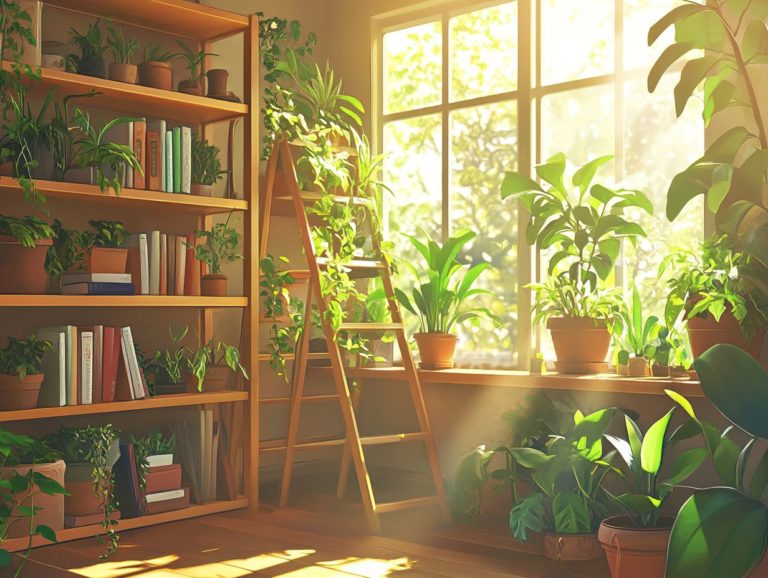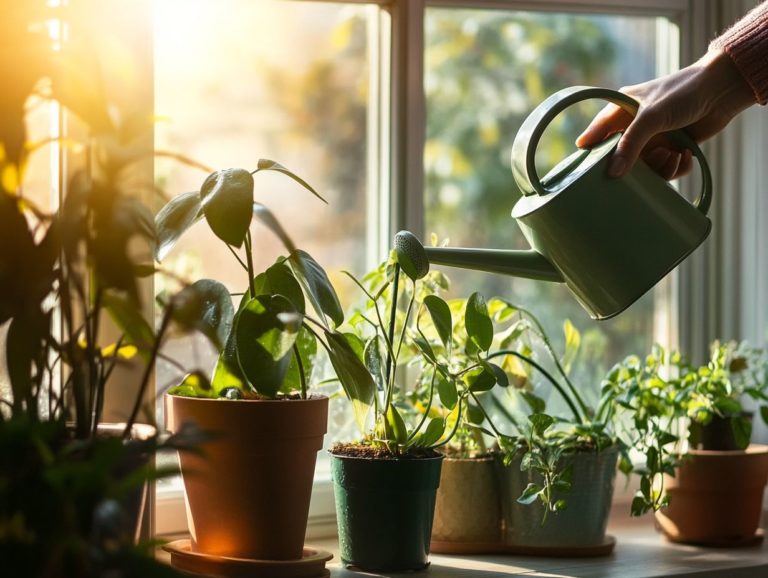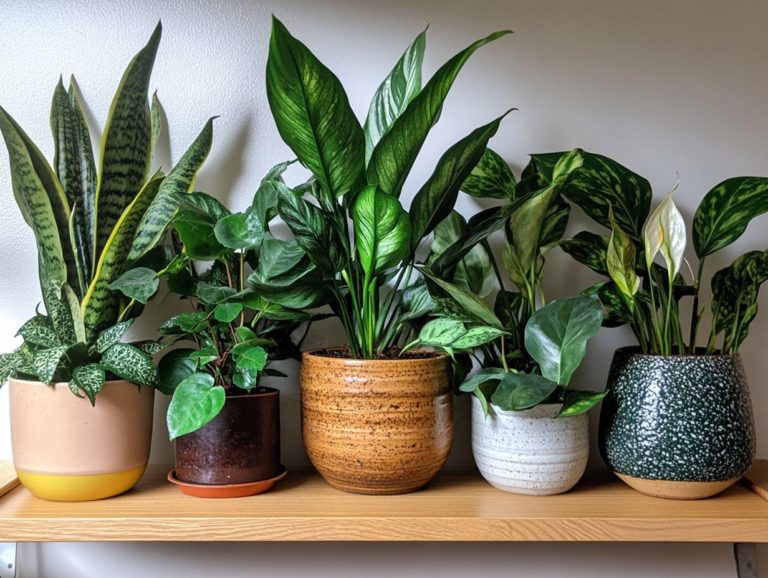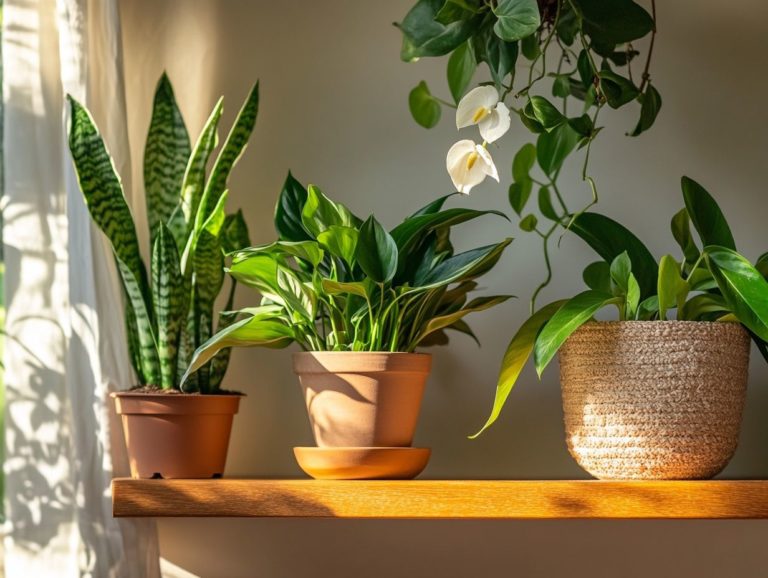What are the Best Indoor Plants for Airflow?
Indoor airflow is crucial for a healthy living environment. It directly affects the air quality you breathe. Neglecting indoor air quality can lead to various health issues, including allergies and respiratory problems that can disrupt your daily life.
One effective way to enhance airflow and purify the air in your space is by introducing indoor plants. This article delves into the best plants for elevating indoor air quality, the key factors to consider when choosing them, and tips to ensure your green companions flourish.
Discover how easy it is to breathe better with simple indoor plants today!
Contents
- Key Takeaways:
- The Importance of Indoor Airflow
- How Indoor Plants Can Help Improve Airflow
- Top Indoor Plants for Airflow
- Factors to Consider When Choosing Indoor Plants for Airflow
- Tips for Maintaining Healthy Airflow with Indoor Plants
- Frequently Asked Questions
- What are the Best Indoor Plants for Airflow and Air Purification?
- Can indoor plants really improve air quality?
- Which indoor plants are low maintenance and still great for airflow, especially in low light conditions?
- How many indoor plants do I need to effectively improve airflow in a room?
- Are there any specific indoor plants that are known for reducing humidity in a room, while still providing aesthetic appeal?
- Do all indoor plants have the same air purifying benefits according to the NASA study?
Key Takeaways:
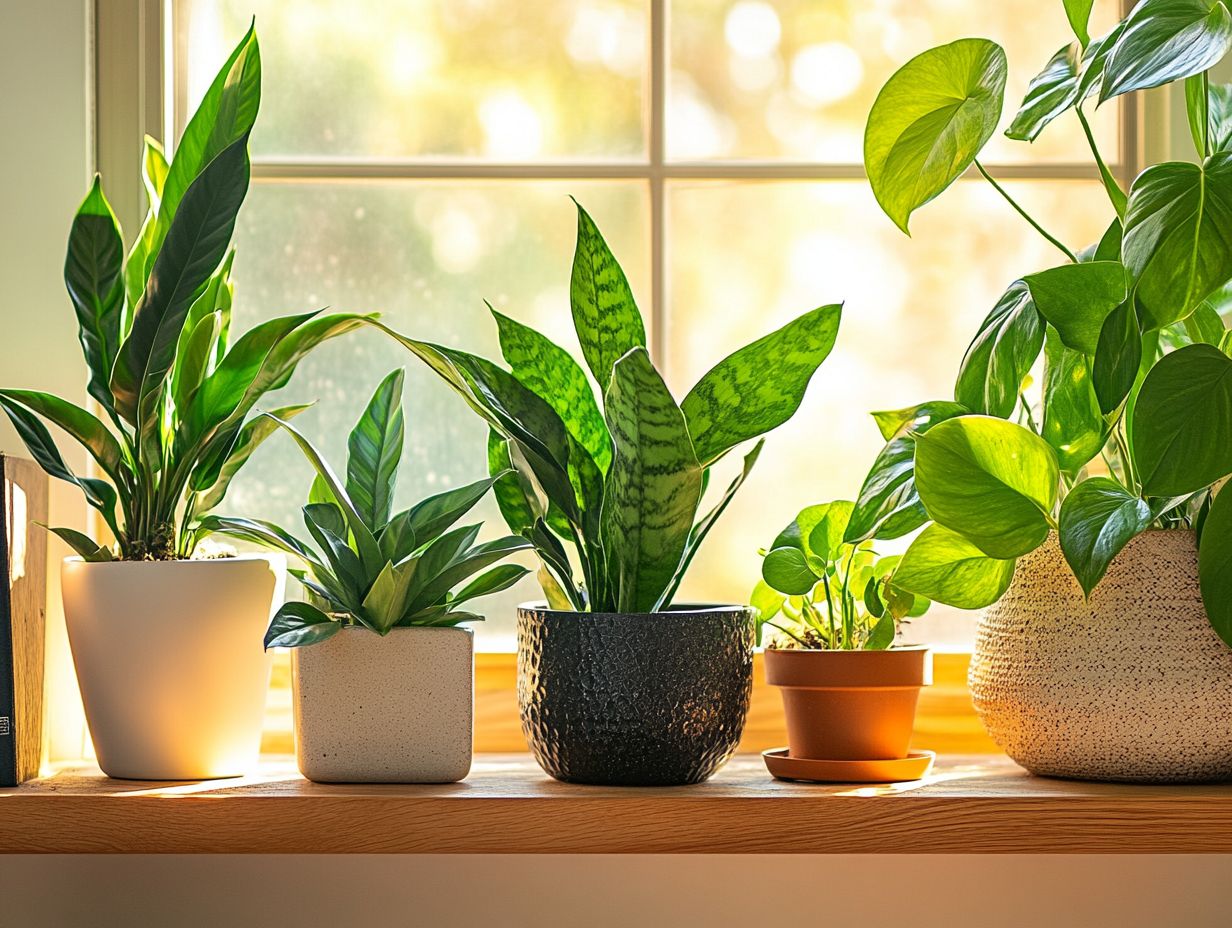
- Indoor airflow is crucial for our health and well-being; poor airflow can have negative effects on physical and mental health.
- Certain indoor plants have natural air purifying and oxygenating properties, making them perfect for improving airflow in our homes and offices.
- Choose indoor plants based on light, water needs, and their size for optimal placement, as proper care is essential for maintaining healthy airflow.
The Importance of Indoor Airflow
Indoor airflow plays a pivotal role in creating a healthy living environment. Harmful pollutants like volatile organic compounds (VOCs), formaldehyde, and benzene can accumulate, often lurking in common household products and seriously affecting your health.
Inadequate airflow leads to higher humidity levels, encouraging the growth of mold and dust mites, which further compromise air quality. Understanding airflow s impact can transform your well-being and can be beautifully enhanced by incorporating specific houseplants into your space.
Effects of Poor Airflow on Health and Well-being
Poor indoor airflow can lead to a range of health issues, including respiratory problems and allergies. Increased exposure to harmful toxins lurking in the air poses additional risks.
For those dealing with asthma, stagnant air can be particularly troubling, aggravating symptoms and resulting in increased wheezing and difficulty breathing. Allergies often become more pronounced in environments with subpar air quality, manifesting as sneezing, nasal congestion, or even skin irritations.
Some indoor plants can release airborne toxins that may worsen these health concerns. Tackling poor airflow and carefully considering the types of plants in your home can significantly enhance air quality and contribute to overall well-being.
How Indoor Plants Can Help Improve Airflow
Indoor plants are essential allies in your quest for improved airflow and enhanced air quality. They diligently absorb harmful toxins like formaldehyde and benzene, effectively lowering the concentration of harmful chemicals found in many products.
Embracing plants such as the spider plant, snake plant, and peace lily not only adds beauty to your environment but also ensures a healthier atmosphere through their remarkable air-filtering capabilities. Their oxygen-releasing prowess during the day significantly contributes to better respiratory health and overall well-being.
Start your journey towards fresher air today by introducing the right indoor plants into your home!
Natural Air Purifying and Oxygenating Properties

Houseplants possess remarkable air-purifying and oxygenating properties that can significantly elevate the quality of your indoor environment. They are essential for modern living spaces.
Among these verdant allies, the spider plant, golden pothos, and rubber plant stand out for their exceptional toxin-filtering capabilities. Research by environmental scientists shows that these plants effectively eliminate harmful substances like formaldehyde, benzene, and xylene from the air.
Notably, the NASA Clean Air Study identifies the spider plant as a top performer in enhancing indoor air quality. You ll love how these plants not only look great but also boost your health!
Experts recommend incorporating these plants not just for their visual appeal, but also for the substantial health benefits they bring, fostering a fresher and more vibrant living atmosphere.
Top Indoor Plants for Airflow
Selecting the right indoor plants can significantly elevate the airflow and air quality in your home. Each plant has distinct advantages that contribute to a more vibrant and healthy living environment.
Specific Plants and Their Benefits
Plants like the peace lily, snake plant, spider plant, and golden pothos are not just visually appealing; they also deliver impressive health benefits by purifying the air you breathe.
These extraordinary plants work tirelessly to eliminate harmful toxins such as formaldehyde, benzene, and xylene from your environment. For example, the peace lily absorbs pollutants while thriving in low light making it a great companion for your indoor spaces.
The snake plant excels at converting CO2 into oxygen at night, ensuring your air quality remains fresh while you sleep. Meanwhile, the resilient spider plant grows quickly, producing oxygen-rich air. For those new to indoor gardening, the best indoor plants for beginners include golden pothos, which stands out for its effortless care and striking foliage, effectively reducing indoor air toxins.
Research underscores the positive influence of these plants on your overall well-being. Indoor greenery can enhance mental health and boost productivity.
Factors to Consider When Choosing Indoor Plants for Airflow
When you’re choosing indoor plants to enhance airflow in your space, consider these key factors: light conditions, water requirements, size, and strategic placement.
Each plant species has unique needs, and understanding these requirements is essential for optimal growth and maximizing air purification. For instance, while some plants thrive in low light, others need bright, indirect sunlight to flourish.
The balance of water and humidity significantly impacts how effectively a plant can filter toxins and enhance your air quality.
Light and Water Requirements
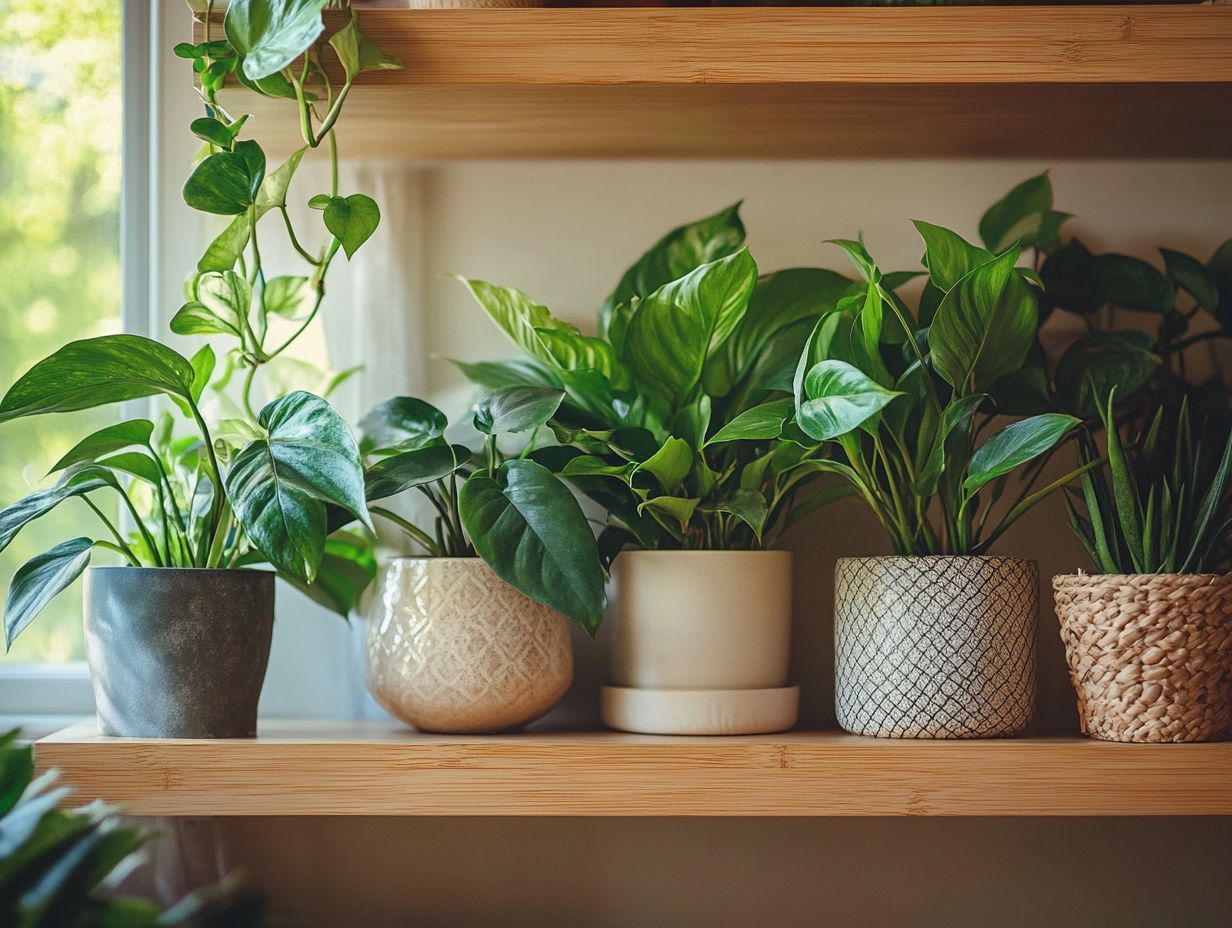
Understanding the light and water requirements of your indoor plants is crucial for their health and for maximizing their air-purifying capabilities.
Different species thrive under different conditions, so it’s essential to identify which plants are best suited for your specific environment. For example, succulents and cacti prefer bright, direct sunlight and need minimal watering, while tropical plants like ferns thrive in indirect light and favor consistently moist soil.
By choosing plants that harmonize with the unique conditions of each room, such as the peace lily and spider plant, you can cultivate a beautiful indoor ecosystem that not only enhances your space but also improves air quality. This mindful approach to plant care will lead to flourishing greenery that contributes to a healthier living environment, removing toxins and elevating your overall well-being.
Size and Placement in the Room
The size and strategic placement of indoor plants, especially larger species like the rubber plant, can significantly enhance both airflow and the aesthetic charm of your home.
By carefully arranging a combination of large, medium, and small plants throughout various areas of a room, you can cultivate a harmonious environment that promotes air circulation while elevating visual appeal. For example, towering plants in corners serve as natural air purifiers, effectively drawing in stale air and releasing fresh oxygen. If you’re looking for options, consider learning about the most resilient indoor plants that thrive in various conditions. Smaller plants on shelves or tabletops can fill empty spaces without overwhelming your senses.
Think about positioning leafy varieties near windows, where they can get sunlight. This not only boosts their air-filtering capabilities but also contributes positively to the overall ambiance of your indoor space. If you’re looking for options, consider checking out the best indoor plants for low light.
Tips for Maintaining Healthy Airflow with Indoor Plants
Keep your indoor plants happy and healthy for fresh air! To maintain healthy airflow, you’ll need to commit to diligent plant care. This involves regularly monitoring humidity levels, ensuring consistent watering, and keeping your plants free from pests and diseases.
Your attention to these details will create a thriving environment for both your plants and your space.
Proper Care and Maintenance Techniques
Proper care and maintenance techniques are essential for ensuring that your indoor plants thrive and actively improve airflow in your home.
By establishing a structured routine that includes regular watering, precise pruning, and monitoring humidity levels, you can create an optimal environment for your green friends. Overwatering can lead to root rot, while underwatering can result in wilting; finding that perfect balance is crucial.
Periodic pruning encourages new growth and helps eliminate dead or yellowing leaves, which can attract pests. Being attuned to signs of distress, such as browning tips or drooping leaves, allows you to adjust your care strategies promptly. Maintaining adequate humidity levels is key, as many plants thrive in more humid environments. Simple solutions like grouping your plants together or using a humidity tray can work wonders.
Frequently Asked Questions
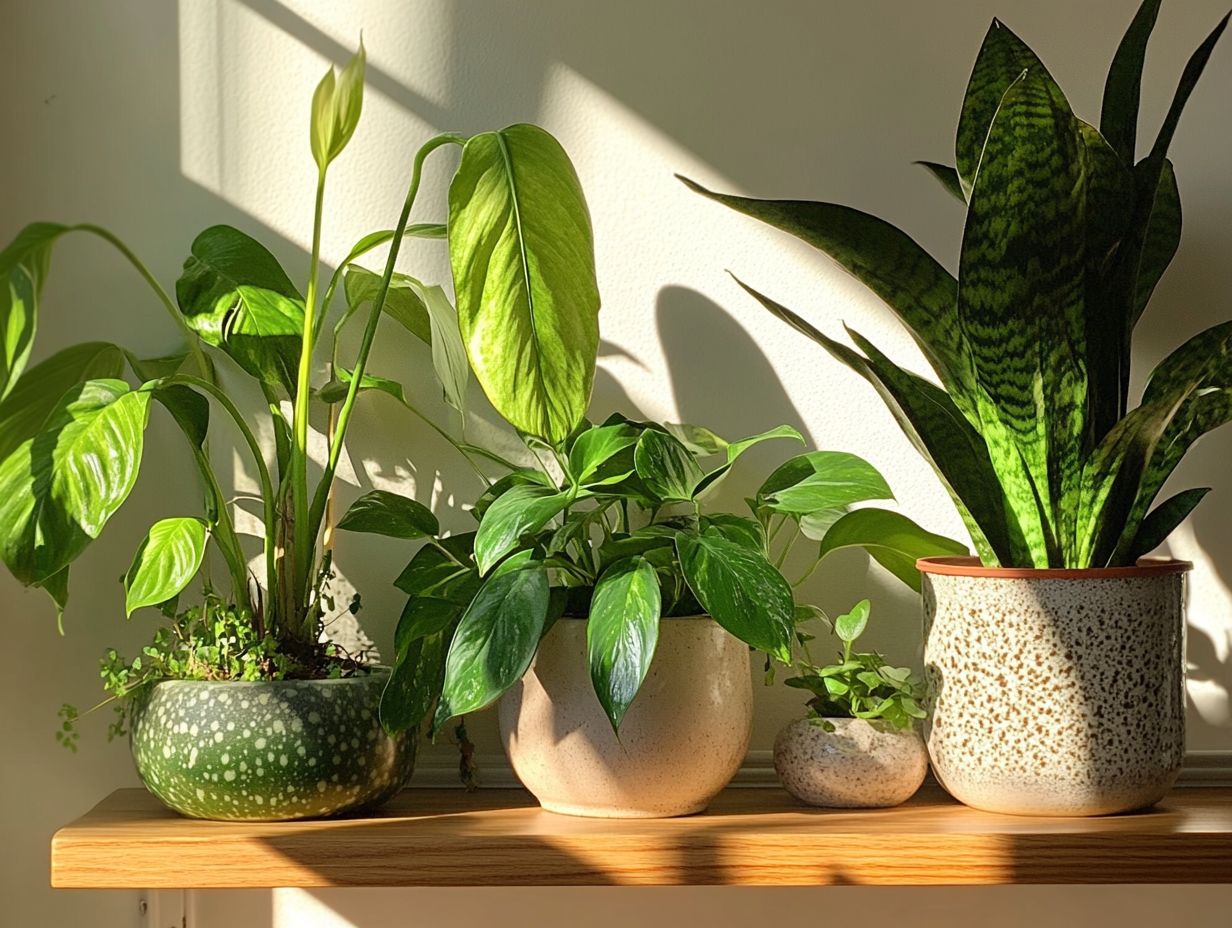
What are the Best Indoor Plants for Airflow and Air Purification?
The best indoor plants for airflow are those known for their air-purifying properties, such as snake plants, peace lilies, and spider plants.
Can indoor plants really improve air quality?
Yes, indoor plants have been proven to improve air quality by filtering out harmful pollutants and toxins in the air.
Which indoor plants are low maintenance and still great for airflow, especially in low light conditions?
Some low maintenance indoor plants that are great for airflow include aloe vera, pothos, and Chinese evergreen. Explore these options for a beautiful, easy-to-care-for indoor garden!
How many indoor plants do I need to effectively improve airflow in a room?
The number of indoor plants needed to improve airflow depends on the room’s size and the type of plants. A general rule of thumb is to have one plant for every 100 square feet of space, ensuring a good balance between aesthetics and functionality.
Are there any specific indoor plants that are known for reducing humidity in a room, while still providing aesthetic appeal?
Yes, plants like Boston ferns, English ivy, and bamboo palm are known for their ability to reduce humidity levels while enhancing your space’s beauty.
Do all indoor plants have the same air purifying benefits according to the NASA study?
No, not all indoor plants have the same air purifying benefits. Some plants are more effective at filtering out certain pollutants than others, so it’s important to research which plants are best for your specific air quality concerns.


